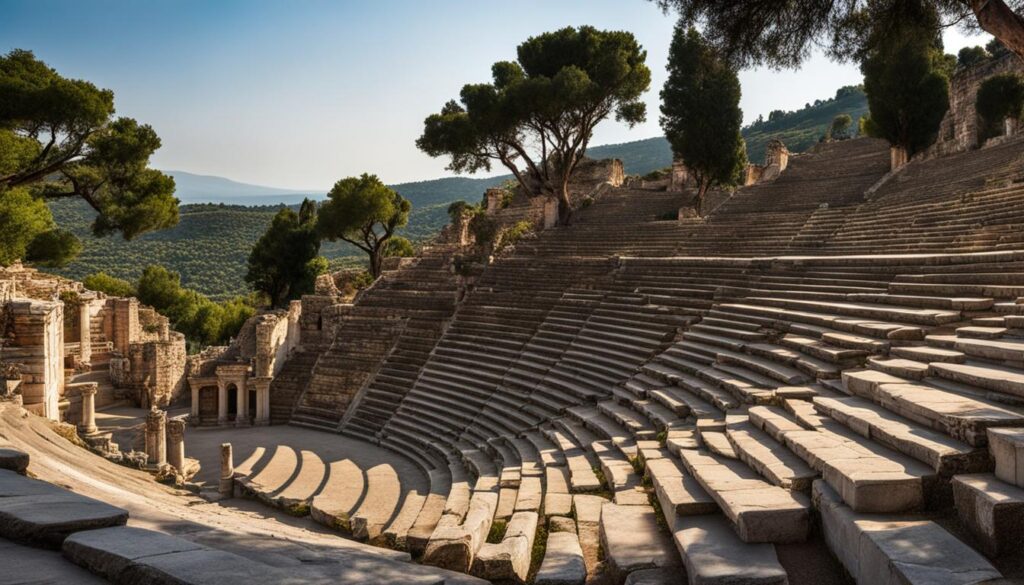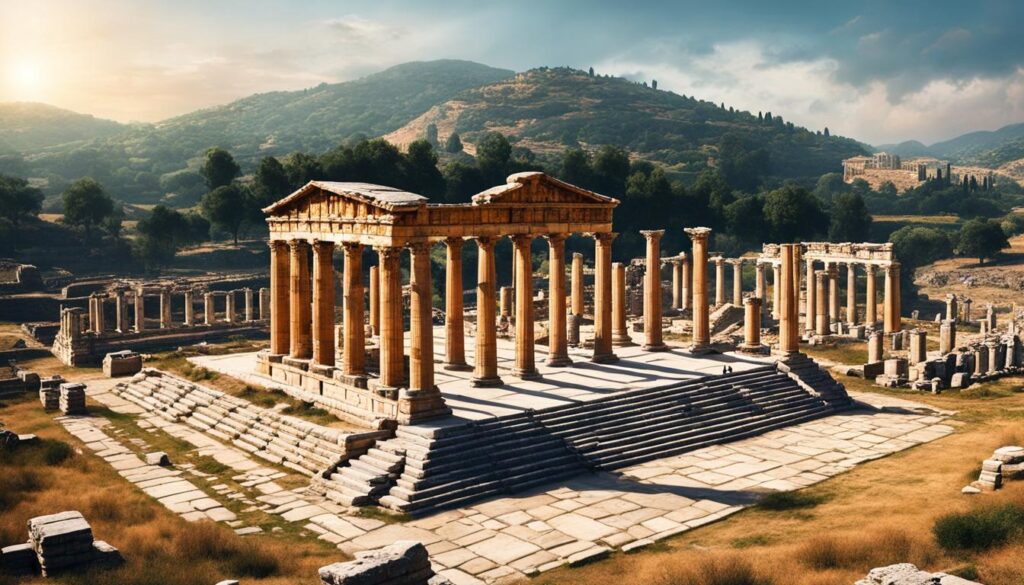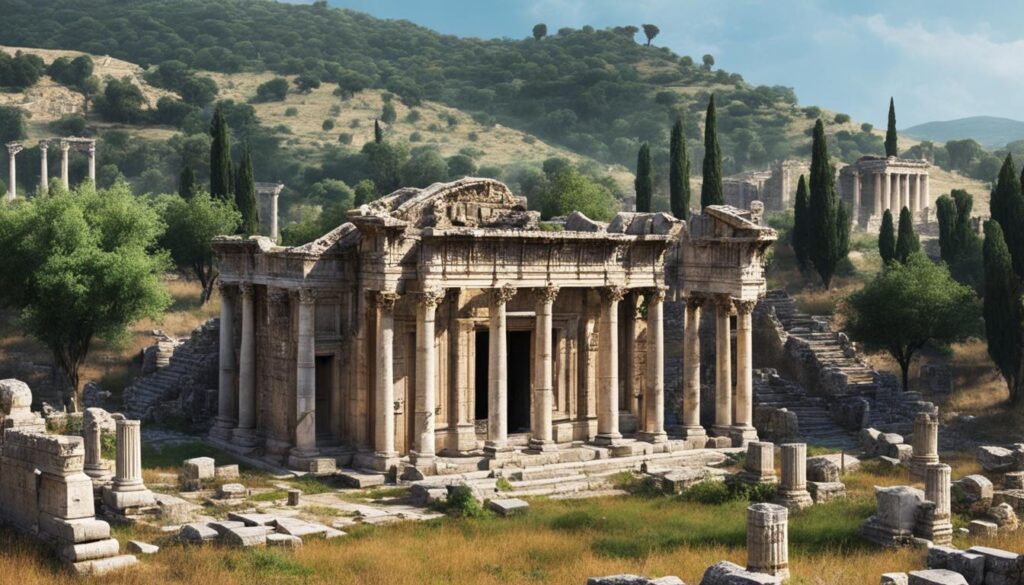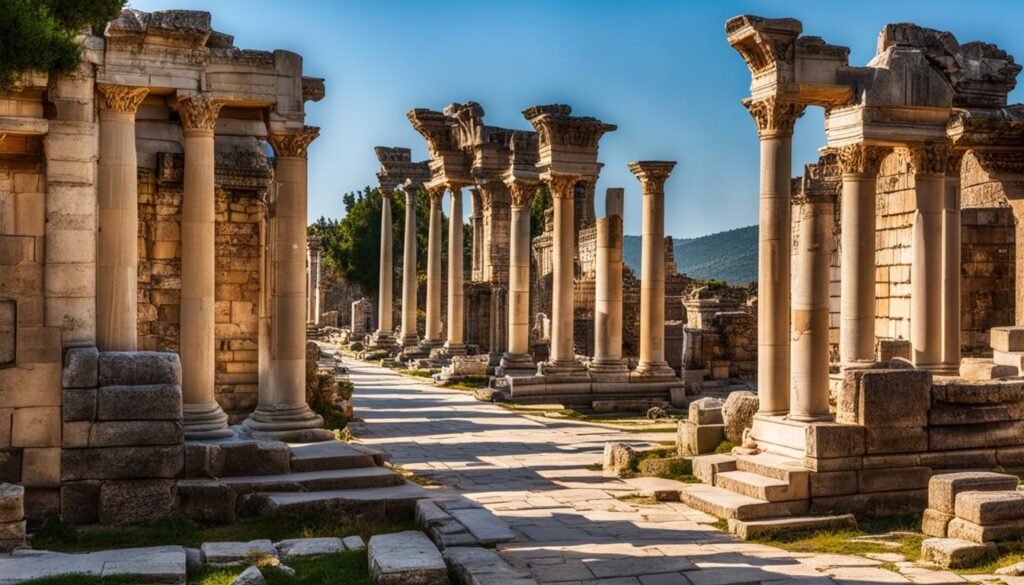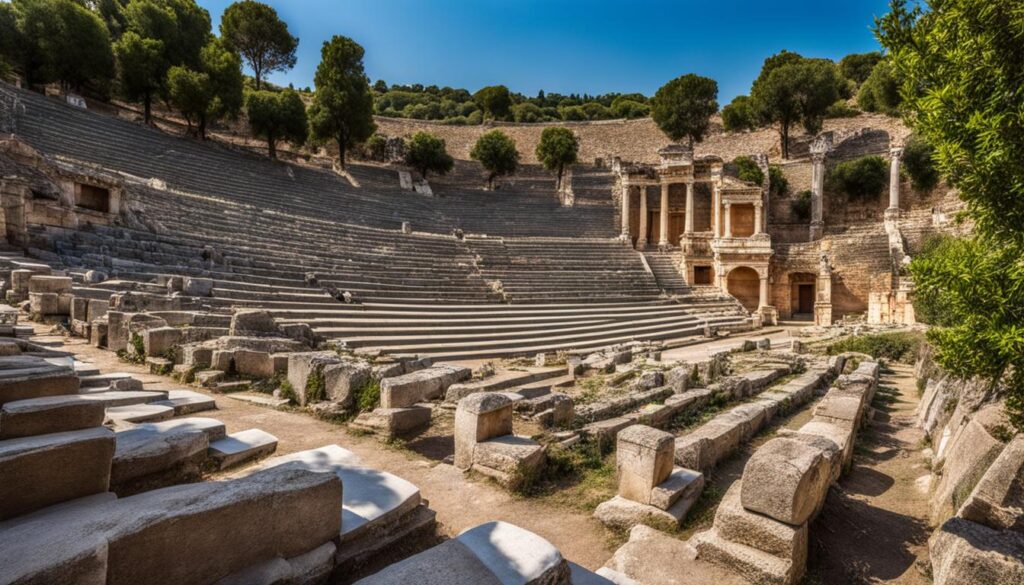Are you searching for the best-preserved ruins in Ephesus? In addition to the iconic Library of Celsus, this historic city is home to a plethora of remarkable archaeological sites that are waiting to be explored.
From the magnificent amphitheater of the Grand Theater to the intricate mosaics of the Terrace Houses, Ephesus attractions are a testament to the ancient world’s grandeur and sophistication. The ruins beyond the Library of Celsus offer stunning insights into the past that will make your Ephesus ruins tour an unforgettable experience.
So, what are the best-preserved ruins in Ephesus beyond the Library of Celsus? Let’s delve deeper into this subject and discover the hidden treasures of Ephesus together.
The Grand Theater
When embarking on your Ephesus ruins tour, The Grand Theater is a must-see among ancient ruins and Ephesus tourist attractions. The construction of this magnificent amphitheater dates back to the Hellenistic period and was later rebuilt by the Romans in the 1st century AD. It had the capacity to accommodate up to 25,000 spectators and hosted various cultural and entertainment events, including gladiator fights and theatrical performances.
The impressive structure stands as a testament to the creativity and engineering expertise of the ancient world. The theater’s seating area is a sight to behold, with a semicircular arrangement of rows and marble seats with a prime view of the stage. The stage building is also well-preserved, with two main levels and a beautifully decorated facade adorned with marble reliefs.
Take a moment to sit down and immerse yourself in history while reflecting on the grand performances that once graced this iconic venue. Be sure to capture the moment with some photos of the magnificent ruins.
Ephesus tourist attractions: Grand Theater Facts
| Fact | Details |
|---|---|
| Construction | The Hellenistic period, rebuilt by the Romans in the 1st century AD |
| Capacity | Approximately 25,000 spectators |
| Use | Cultural and entertainment events, including gladiator fights and theatrical performances |
| Features | Semicircular seating arrangement, marble seats, two-level stage building, decorated facade with marble reliefs |
Temple of Artemis
The Temple of Artemis is one of the most fascinating historical sites in Ephesus. This ancient temple was dedicated to Artemis, the Greek goddess of hunting, fertility, and childbirth. It was once considered one of the Seven Wonders of the Ancient World and was recognized for its architectural beauty and grandeur.
The remains of this remarkable temple are a significant archaeological site in Ephesus, offering a glimpse into the life of the ancient world. The temple’s construction spanned over a century, from the 6th to the 5th century BC. The temple’s architecture was an impressive feat, featuring over a hundred marble columns, each 60 feet tall and decorated with intricate carvings of lions, bulls, and other animals.
The Temple of Artemis suffered various damages throughout its history, from being burnt down by a hero to being plundered by the Goths. Today, only a few remains of this once-great structure remain. Nevertheless, the site’s importance in history and its architectural feats are awe-inspiring and worth marveling.
The Temple of Artemis is undoubtedly a must-visit attraction for anyone interested in Ephesus’s archaeological sites. Plan your Ephesus travel guide to include this remarkable historical site and immerse yourself in the rich history of this remarkable city.
Terrace Houses
When exploring Ephesus, you cannot miss visiting the Terrace Houses, also known as the Houses of Rich. These well-preserved residential buildings offer a fascinating insight into the luxurious lifestyle of the wealthy citizens of ancient Ephesus.
The Terrace Houses were constructed during the 1st century AD and are located on the slopes of Bulbul Mountain, opposite the Temple of Hadrian. This unique complex consists of six houses, including one with a beautiful mosaic courtyard, whose walls are covered in frescoes and adorned with architectural elements.
Thanks to the meticulous renovation and maintenance work, visitors can marvel at the intricate mosaics, frescoes, and architectural details that have survived from ancient times. The houses feature multiple levels, courtyards, and water features, attesting to the advanced engineering skills and aesthetics of the Romans.
If you’re interested in learning about the everyday life of the rich, then the Terrace Houses are a must-visit. Here, you can observe the way the elite classes lived and gain a deeper understanding of their customs and values.
What to Expect:
When visiting the Terrace Houses, expect to see an impressive collection of well-preserved residential buildings from ancient times. These houses belonged to the wealthy citizens of Ephesus and feature intricate mosaics, frescoes, and architectural details.
Why Visit the Terrace Houses:
- The Terrace Houses offer a unique opportunity to see how the wealthy citizens of Ephesus lived during ancient times.
- The intricate and well-preserved mosaics, frescoes, and architectural details are truly remarkable, showcasing the advanced engineering and aesthetic achievements of the Romans.
- The Terrace Houses are an essential part of exploring Ephesus, providing a deeper understanding of the customs and values of the elite classes of the past.
Temple of Hadrian
The Temple of Hadrian is a testament to ancient architectural prowess. It is one of the Ephesus archaeological sites that you should not miss when exploring Ephesus tourist attractions. This beautifully-crafted temple has intricate details that will leave you in awe. The temple is dedicated to Emperor Hadrian and contains expertly carved reliefs that depict various mythological scenes. These intricate carvings highlight the artistic and cultural significance of this ancient monument.
Curetes Street
Immerse yourself in the ancient world as you stroll down Curetes Street, the main thoroughfare of ancient Ephesus. This well-preserved street is lined with ancient ruins of shops, houses, and public buildings, providing a glimpse into the daily life of the Ephesians.
Don’t miss the chance to admire the intricate details of the structures and experience the vibrant atmosphere of this once-thriving city. While exploring this Ephesus attraction, you can also catch a glimpse of the well-preserved public toilets, a testament to the city’s sophistication.
Highlights of Curetes Street
| Attractions | Description |
|---|---|
| The Hercules Gate | Ancient entrance featuring reliefs of Hercules and other mythology figures. |
| Latrines | Public toilets with marble seats, an impressive feat of engineering in ancient times. |
| The Temple of the Sebastoi | Dedicated to the Emperor Augustus and his family, this temple features intricate carvings and details. |
As you wander down Curetes Street, you’ll have plenty of photo opportunities to capture the beauty of these ancient ruins. Take in the sights and imagine what life was like in the bustling city of Ephesus thousands of years ago.
The Odeon
As you explore the ancient city of Ephesus, make sure to visit The Odeon, a fascinating theater structure used for musical performances and council meetings. The Odeon had a seating capacity of around 1,500 people and was famous for its unique sloping stage. The theater hosted a variety of events, from concerts to poetry recitals, and was a hub of cultural activity in ancient Ephesus.
Today, The Odeon stands as a well-preserved example of ancient Roman architecture, complete with ornate columns and detailed carvings. Take a step back in time and imagine the vibrant atmosphere of this ancient venue, filled with the sounds of music and voices raised in debate!
Why You Should Visit The Odeon
- Experience the sound of ancient music in an authentic Roman theater
- Enjoy the unique sloping stage design, typical of ancient theaters
- Appreciate the intricate carvings and details of Roman architecture
- Get a sense of the cultural and political events that took place in ancient Ephesus
“The Odeon is a must-see for anyone interested in ancient music, theater, or politics. Its unique design and historical significance make it a highlight of any Ephesus travel guide.” – Famous Historian
The Temple of Domitian
If you love exploring historical sites in Ephesus, the Temple of Domitian is a must-visit attraction. Ephesus tourist attractions offer a glimpse of the grandeur of Roman architecture and the historical significance behind it.
The Temple of Domitian stands out as a well-preserved testament to the Roman Empire’s influence on Ephesus. Erected in A.D. 82, under Emperor Domitian’s rule, it was dedicated to his elder brother, Titus, the former emperor who had died the same year.
| Location | Visiting hours | Ticket price |
|---|---|---|
| Ancient City of Ephesus, Turkey | 8:00 am to 6:30 pm | $15 USD |
Despite suffering damage from earthquakes and fires throughout the years, the Temple of Domitian’s ruins remain an excellent example of the majestic architecture of the Roman era. You’ll find some of the temple’s notable structures, such as the podium and the cella—once home to the temple’s statue—still intact.
“The Temple of Domitian is a testament to the grandeur and influence of the Roman Empire on Ephesus’ history.”
Explore the remains and learn how the temple’s structure and design differ from other structures in Ephesus. Don’t forget to take photos of the intricate details and reliefs and enjoy your Ephesus tourist attractions experience.
The Great Theater Gymnasium
Step back in time and experience the ancient world of fitness and relaxation at the Great Theater Gymnasium in Ephesus. This impressive complex includes a bathhouse, exercise areas, and a large open courtyard where athletes and spectators gathered for games and competitions.
The Great Theater Gymnasium was an essential part of daily life for Ephesians, providing a space for physical exercise, socializing, and relaxation. The remains of the complex showcase the architectural and engineering skills of the ancient Greeks and Romans.
The Bathhouse
The bathhouse was an essential part of Roman life, and the one at Great Theater Gymnasium was no exception. The facility had separate areas for men and women with hot and cold baths, steam rooms, and massage rooms. The bathhouse was a social hub where people could catch up on gossip and politics while enjoying the warm waters.
The Exercise Areas
The Great Theater Gymnasium offered numerous exercise areas, including a palaestra for wrestling and boxing, a running track, and a stadium for various sports. Athletes competed in games and festivals, showcasing their skills and representing their cities.
The Courtyard
The Great Theater Gymnasium featured a large open courtyard where people could sit and relax after a workout or watch athletic competitions. The courtyard was the central gathering place for the community and hosted events such as music and theater performances.
Visit the Great Theater Gymnasium and discover the rich history and culture of ancient Ephesus. This site is a must-see for anyone interested in Ephesus archaeological sites and attractions.
Fountain of Trajan
As you explore Ephesus, you’ll come across the Fountain of Trajan, an ancient fountain that once served as the city’s water supply. This incredible monument is a testament to the engineering marvels that existed in ancient times. You’ll be amazed by the intricate sculptures, including depictions of Trajan and his wife, as well as representation of gods and goddesses.
The Fountain has five tiers, adorned with decorative wreaths, swans, and grotesque masks. It stands at the intersection of Curetes Street and the Marble Road, near the entrance of the Prytaneion. Situated in the city center, the Fountain represents a vital landmark in Ephesus’s bustling and vibrant urban setting.
Symbolism and Significance
This ancient fountain has both artistic and practical value, bringing fresh water to the city of Ephesus while also serving as a beautiful symbol of the city’s sophistication. The Fountain of Trajan embodies the fusion of Roman and Greek cultures, two elements of immense influence in the city’s history.
“The Fountain of Trajan remains one of the most significant monuments in the city of Ephesus, as it has done for centuries.”
Dr. Elizabeth Peters, Ephesus Archaeologist
Many visitors to Ephesus are fascinated by the symbolism of the fountain’s decoration. The swans decorating the tiers of the fountain symbolize purity and represent spiritual refinement. The masks that adorn the fountain’s lower tiers illustrate ancient mythological tales of water deities. The fountain’s impressive details and intricate carvings invite visitors to take a journey into Ephesus’s rich history and culture.
The Prytaneion
As you continue your exploration of Ephesus, don’t miss the opportunity to visit the Prytaneion. This important building was the central point of political and religious life in the city. The Prytaneion served as the residence of the city’s governing council and hosted important ceremonies and rituals.
The sacred hearth, located inside the Prytaneion, was constantly burning as a symbol of the city’s eternal life. The Prytaneion was also a place where visiting dignitaries were entertained.
Today, visitors can see the remains of the Prytaneion and imagine the lively political and religious activity that once took place here. Take a moment to appreciate this fascinating historical site during your Ephesus travel guide.
Interesting Facts
The Prytaneion was considered one of the most sacred buildings in Ephesus, and its sacred hearth was believed to be a symbol of the city’s continuity.
| Location: | Ephesus Archaeological Site |
|---|---|
| Opening Hours: | 8:00 am – 6:00 pm (summer), 8:00 am – 5:00 pm (winter) |
| Ticket Price: | included in the admission fee to the Ephesus Archaeological Site |
Conclusion
If you are planning to visit Ephesus, make sure to have a comprehensive Ephesus travel guide to help you navigate the city’s historical sites. Joining an Ephesus ruins tour can further enhance your experience, as you explore the best-preserved ruins beyond the iconic Library of Celsus. From the magnificent Grand Theater to the significant Temple of Artemis and the fascinating Terrace Houses, Ephesus offers a rich history that is waiting to be discovered. Stroll along Curetes Street, marvel at the intricate details of the Temple of Hadrian and the Fountain of Trajan, and learn about the politics and religion of the city at the Prytaneion. Finally, experience the ancient world of fitness and relaxation at the Great Theater Gymnasium. With its remarkable archaeological sites and ancient ruins, Ephesus is a destination that should be on every traveler’s list.






























